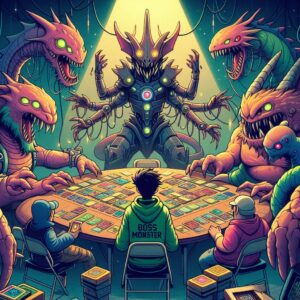Getting Started with Your Tournament
The first step in organizing a tournament is to solidify your understanding of Boss Monster’s mechanics, rules, and possible strategies. Being well-versed in the intricacies of the game allows you to serve as a capable referee who can address questions and resolve disputes effectively. Familiarize yourself with the latest updates and expansions to ensure your tournament remains relevant and exciting.
To choose a format, you must contemplate the expected number of participants, the time available for the event, and the competitive atmosphere you wish to foster. Single and double-elimination brackets are apt for concise, intense competitions, ensuring a straightforward progression towards a champion. Round-robin or Swiss formats allow participants multiple opportunities to play, enhancing the experience for everyone involved.
Securing a convenient and comfortable venue should be accessible, well-lit, and large enough to accommodate your participants and their needs. For online tournaments, choosing a reliable digital platform is vital to simulate as closely as possible the experience of playing in person. Setting a date requires careful consideration of community calendars to avoid clashes with holidays or other local events, thus maximizing attendance.
Utilize various platforms—social media, local gaming store boards, online gaming forums—to share detailed information about your event. Clarity regarding the format, rules, potential entry fees, and prizes is essential. Encouraging pre-registration can significantly aid in logistical planning, giving you a clear picture of the number of participants to expect.
Preparing for the Big Day
 The core of any successful Boss Monster tournament is ensuring all game materials are ready and accessible. This involves securing an adequate number of Boss Monster base game sets and any expansions you plan to include. If you expect a high number of participants, consider having multiple copies of the game to prevent waiting times and delays.
The core of any successful Boss Monster tournament is ensuring all game materials are ready and accessible. This involves securing an adequate number of Boss Monster base game sets and any expansions you plan to include. If you expect a high number of participants, consider having multiple copies of the game to prevent waiting times and delays.
Well-defined rules cover aspects such as the allowed expansions, the structure of the tournament (e.g., number of rounds, time limits per round), and how winners are determined in various scenarios. Plan for how to handle tiebreakers and any unexpected situations that may arise.
It is advisable to document these rules and share them with participants ahead of the tournament. This provides a reference point should any questions or disputes arise during the event.
Ensure that participants can register easily, whether through online platforms for preregistration or a designated area for on-site sign-ups. For physical tournaments, a smooth check-in process, with a clear signposting of the registration area, will help avoid bottlenecks and delays. Having a team ready to welcome participants, provide them with necessary materials or badges, and guide them to their starting locations can significantly enhance the participant experience.
Running the Tournament
Opening the tournament with a brief and clear presentation sets a welcoming and professional tone for the event. Begin by greeting the participants and expressing appreciation for their attendance. Follow this with a concise overview of the tournament structure, the schedule for the day, and a reiteration of the key rules. This initial briefing helps in building excitement and anticipation for the competition ahead.
Utilize a timer to ensure that each game adheres to the pre-defined time limits, thus preventing any one match from excessively prolonging the tournament.
Implement a clear system for reporting match results. This system should be explained during the opening presentation to prevent confusion. It is beneficial to have a visible scoreboard or bracket update system, so participants can track their progress and the tournament’s overall progression.
As the organizer, you ensure the tournament’s integrity by overseeing fair play and promptly addressing any disputes that arise. Familiarity with the game and its rules is important, as you may need to make judgment calls or clarify misunderstandings. Approach disputes with impartiality and professionalism, focusing on the facts and the ruleset established for the tournament.
Where the rules do not provide a clear resolution, prioritize fairness and the spirit of competition in making your decision. Communicate this decision clearly to the involved parties, ensuring they understand the rationale behind it.
Encourage sportsmanship, celebrate noteworthy plays and achievements, and maintain an open and approachable demeanor. Creating a positive atmosphere encourages community building among participants.
Consider implementing side activities or casual play areas for those awaiting their next match or who have been eliminated from the tournament. This approach keeps all participants engaged and ensures that everyone, regardless of their competitive success, enjoys their time at the event.
Wrapping Up
At the tournament’s conclusion, conduct a formal award ceremony to acknowledge the winners and participants. Clearly announce each winner and provide a brief description of their journey through the tournament to the final victory. Distribute prizes in a manner that highlights the achievement and effort put in by the participants. While the focus is often on the top performers, consider recognizing unique achievements or efforts with special awards or mentions. This encourages participation and celebrates the diversity of skills within the Boss Monster community.
 After the tournament, seek participants’ opinions on what they enjoyed and areas for improvement. This can be done through post-tournament surveys, informal conversations, or digital feedback forms. Questions should cover the tournament’s structure, venue, rules, and overall atmosphere to gain comprehensive insights.
After the tournament, seek participants’ opinions on what they enjoyed and areas for improvement. This can be done through post-tournament surveys, informal conversations, or digital feedback forms. Questions should cover the tournament’s structure, venue, rules, and overall atmosphere to gain comprehensive insights.
Critically analyze this feedback, identifying patterns or common suggestions that can help refine future tournaments. Being open to participants’ perspectives fosters a sense of community by showing that their input is valued and considered.
Documenting and sharing the tournament’s highlights could include a summary of the tournament, notable matches, standout strategies, and photos or videos of the event. Utilize social media, community forums, or an event webpage to share these moments. Highlighting the achievements of participants and recapping the event’s success stories not only serves as a record but also promotes the game and the community around it.
The success of a tournament is not solely the result of an organizer’s efforts but also depends on the participants, volunteers, and possibly sponsors. Take the time to personally thank everyone involved. Acknowledgments could be in the form of thank-you notes, social media shoutouts, or mention during the awards ceremony. This token of appreciation reinforces the positive relationships within the community and encourages continued support and participation in future events.